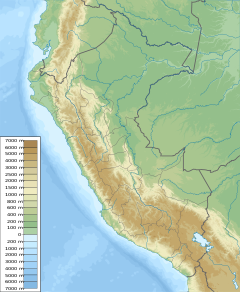Zaña River
| Zaña River | |
|---|---|
 The Zaña River near its mouth. | |
| Location | |
| Peru | Lambayeque, Cajamarca regions |
| Physical characteristics | |
| Source | |
| • coordinates | 6°59′56″S 76°56′24″W / 6.999°S 76.940°W / -6.999; -76.940 |
| • elevation | 3,750 metres (12,300 ft) |
| Mouth | |
• coordinates | 6°55′41″S 78°53′35″W / 6.928°S 78.893°W / -6.928; -78.893 |
• elevation | 0 m (0 ft) |
| Length | 119 kilometres (74 mi) |
| Basin size | 2,158 square kilometres (833 sq mi)[1] |
| Discharge | |
| • average | 202 million m3 (annual); 6.5 m3 per second average [2] |
The Zaña River (also Saña River) is a small river in northern Peru. The river is 119 kilometres (74 mi) in length and begins in the Andes of Cajamarca Region and ends at the Pacific Ocean in Lambayeque Region. In the lower part of the river valley, where the river flows through the coastal desert of Peru, the cultivation of irrigated crops is extensive and the Zaña is usually dry near its mouth. Upriver, at higher elevations in the Andes, precipitation is much greater and downstream floods are common. One such flood wiped out the important city of Zaña in 1720. Zaña has been rebuilt, but has never regained its former prominence as an urban center. Other towns in the lower valley are Mocupe, Cayalti, Nueva Arica, and Oyotun.[3][4]
The most distant source of the Zaña River is at an elevation of 3,750 metres (12,300 ft) at coordinates 6.998° S latitude and 78.83° W longitude.[5]
Vegetation
The semi-tropical forests found at elevations above 2,000 metres (6,600 ft) in the upper parts of the Zaña basin are an unusual feature of the river. The existence of the forests is due to the relatively low elevations of the Andes in this region between the desert coasts of western Peru and the rainforests of the Amazon Basin of the east. Plant and animal species characteristic of the Amazon are found here on the western slopes of the Andes. The Peruvian government recognized the uniqueness of the forests in 2010 by creating the "Reserved Zone of Udima" consisting of 30,503 hectares (75,370 acres) of land overlooking the headwaters of the Zaña.[6] From the lands in the reserved zone, the Bosques Nublados de Udima Wildlife Refuge (Cloud Forests of Udima Wildlife Refuge) with an area of 12,183 hectares (30,100 acres) was created in 2011.[7]
Archaeology
Numerous pre-Columbian ruins are scattered throughout the basin of the Zaña River. Near the Nanchoc river, a tributary of the Zaňa, archaeologist Tom Dillehay has found what may be the oldest irrigation canals in the Americas, radiocarbon dated to at least 3400 BCE and possibly as old as 4700 BCE. The canals built by the people of Nanchoc at that time were utilized to irrigate crops such as peanuts, squash, manioc, and chenopods, a relative of Quinoa.[8]
In 2019, Peruvian archaeologist Walter Alva discovered the ruins of a megalithic temple in the Zaña Valley near Oyotun. The temple, apparently belonging to the Chavin culture (900 to 200 BCE), is 56 metres (184 ft) long and 40 metres (130 ft) wide and built of large stones which were dragged from a long distance to the temple site. The temple is believed by Alva to be part of a larger complex.[9]

References
- ^ "Resumen Ejecutivo: Delimitacion de Faja Margina del Rio Zana" (PDF). Instituto Nacional de Recursos Naturales. Ministry of Agriculture, Peru. Retrieved 30 November 2020.
- ^ Shimada, Izumi (1994). Pampa Grande and the Mochica Culture. Austin: University of Texas Press. p. 42. ISBN 9780292723375.
- ^ "Zaña, Peru: The Town That Almost Was". National Geographic (blogs). Retrieved 2016-03-08.
- ^ Google Earth
- ^ Google Earth
- ^ Angulo Pratolongo, Fernando. "El Valle del rio Zana donde la selva se encuentra con las costas". Xilema. Universidad Agraria Le Molina. Retrieved 29 November 2020.
- ^ "Bosques Nublados de Udima - Servicio Nacional de Áreas Naturales Protegidas por el Estado". www.sernanp.gob.pe (in European Spanish). Retrieved 2018-11-05.
- ^ Dillehay, Tom D.; Eling, Jr., Herbert H.; Rossen, Jack (2005). "Preceramic irrigation canals in the Peruvian Andes" (PDF). Proceedings of the National Academy of Sciences of the United States of America. 102 (47). National Academy of Science: 17241–17244. doi:10.1073/pnas.0508583102. PMC 1288011. PMID 16284247. Retrieved 20 November 2020.
- ^ "Descubren Templo Megalitico de Culto de Agua en Lambayeque". Andina. Retrieved 21 September 2021.
